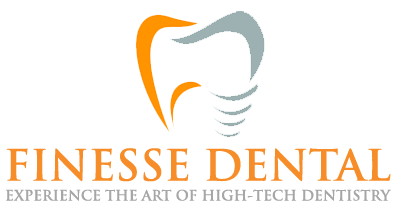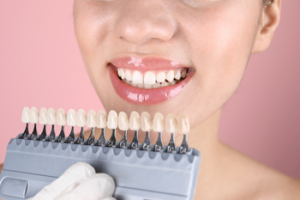The quest for a perfect smile often leads us to explore various cosmetic dentistry procedures. One such popular option is dental veneers, which can turn discoloured, chipped, or uneven teeth into the epitome of dental beauty. However, one aspect that often remains shrouded in mystery is the tooth preparation process—specifically, the teeth shaved for veneers. In this comprehensive blog post, we’ll dive deep into shaved teeth for veneers to dispel myths, discuss clinical guidelines, and explore the pros and cons. So, if you’re considering veneers, read on to make an informed decision.
The What and Why of Tooth Shaving for Veneers
When discussing dental veneers, the primary focus hovers around the aesthetic outcomes, the materials used, or the cost involved; however, a critical yet often overlooked component of this cosmetic procedure is the preparatory step known as “tooth shaving.” This term might conjure up unsettling images, but rest assured, the practice is not as severe as it sounds. Tooth shaving is essential to ensuring your veneers look natural, fit well, and stand the test of time. This expanded section delves into the nitty-gritty details to give you a well-rounded perspective.
What Exactly is Tooth Shaving?
Tooth shaving, clinically known as “tooth reduction” or “enameloplasty,” removes a thin layer of tooth enamel to prepare the tooth for a dental veneer. This is done using a dental handpiece or bur conducted under local anaesthesia to keep you comfortable.
The whole idea is to create a slightly reduced and roughened tooth surface. The newly formed surface offers a stronger bonding substrate for the veneer, reducing the likelihood of detachment or dislodgement. The veneer—usually a thin porcelain or composite resin shell—can then be securely adhered to this modified tooth surface.
The Objective Behind Tooth Shaving
Why go through this process? The answer lies in the delicate balance that needs to be struck between aesthetic appeal and functional integrity. Here’s why tooth shaving is essential:
- Room for the Veneer: Removing a small amount of enamel is necessary for the porcelain veneer to look bulky or artificial, failing to mimic the natural shape of your teeth.
- Adhesion: A prepped tooth surface provides better mechanical retention for the veneer, ensuring it remains securely attached.
- Aesthetic Harmony: Tooth shaving allows for minute adjustments in tooth alignment or shape, allowing the skilled cosmetic dentist to provide a result that blends seamlessly with surrounding teeth.
- Longevity: A well-bonded veneer is less likely to detach or break, providing a long-lasting cosmetic solution.
Tooth Shaving: A Customised Approach
The extent of tooth reduction varies among individuals. It depends on multiple factors, such as the current condition of the teeth, the type of veneer being used, and the specific aesthetic outcomes you’re looking to achieve. Typically, dentists aim to remove as little enamel as possible—a guideline aligned with the ‘minimally invasive dentistry philosophy.’
For instance, if you opt for traditional porcelain veneers, expect a reduction of approximately 0.5 mm of enamel. On the other hand, if you’re going for “no-prep” veneers or composite resin veneers, the amount of teeth shaving required could be minimal or even non-existent in some cases.
Technological Advancements
Technological advancements in dentistry have also given rise to precise methods for tooth preparation. Computer-aided design and manufacturing (CAD/CAM) systems, digital impressions, and 3D imaging help clinicians plan the procedure highly, ensuring minimal removal of healthy tooth structure.
The Role of the Patient and Dentist: A Collaborative Effort
The process is not solely a dentist’s prerogative. Open and honest communication between you and your dental healthcare provider can go a long way in defining the success of the treatment. Discuss your concerns openly, ask for clarification on any aspect you find unclear, and feel free to seek a second opinion if unsure.
By arming yourself with comprehensive knowledge about what tooth shaving entails and why it’s necessary, you’re better equipped to make an informed decision you’re comfortable with.
Types of Veneers and Their Impact on Tooth Shaving
Navigating the world of dental veneers can feel like a labyrinth of choices. The options can seem endless, from the material and texture to longevity and cost. One of the crucial factors that are intrinsically linked to these choices is the matter of tooth shaving. The type of veneer you opt for slightly crooked teeth directly affects the extent to which your natural teeth will need to be modified. To help you sift through the information and make a sound choice, let’s delve into the different types of veneers and how each impacts tooth shaving.
Porcelain Veneers
Porcelain veneers are the most traditional form, celebrated for their durability and life-like appearance. However, this type of veneer is also the thickest, which usually necessitates more significant tooth reduction.
Impact on Tooth Shaving:
- Extent of Reduction: The enamel reduction typically ranges from 0.5 mm to 0.7 mm for porcelain veneers. The exact figure can vary based on individual needs and clinical assessments.
- Strength vs. Aesthetics: The more robust the material, the more shaving is required, but it often results in a more durable and natural-looking veneer.
- Long-term Commitment: Given the irreversible tooth shaving required for porcelain veneers, this is a long-term commitment and should be considered carefully.
Composite Veneers
Composite veneers are made of a resin material, making them less robust than porcelain but more forgiving when it comes to tooth preparation.
Impact on Tooth Shaving:
- Minimalist Approach: Composite veneers usually require less tooth shaving, often in the 0.2 mm to 0.4 mm range. This makes them a more conservative choice.
- Variable Needs: Some cases may require no tooth reduction, particularly when dealing with teeth for veneers that are already small or receded.
- Shorter Lifespan: While less invasive, composite veneers generally don’t last as long as porcelain and may require more frequent replacements.
Temporary Veneers
Temporary veneers serve as a provisional solution for patients awaiting their permanent veneers. They are typically made of acrylic resin and are used to protect the prepared tooth surface in the interim.
Impact on Tooth Shaving:
- Protection for Prepared Teeth: One key benefit is that temporary veneers offer protection for broken teeth that have been prepared for permanent veneers, often alleviating sensitivity to hot and cold substances.
- Trial Period: These temporary fixtures can also serve as a “trial run,” giving you an idea of how your permanent veneers will look and feel.
- Potential Discomfort: On the downside, temporary veneers may not fit as perfectly as permanent veneers, potentially causing some discomfort or issues with bite alignment.
Remember that temporary veneers are not intended for long-term use and are usually replaced with permanent veneers within a few weeks.
The Customised Strategy
The type of veneer you choose will be influenced by various factors—your dental history, the current state of your teeth, your aesthetic expectations, and your budget. Your dentist should provide a tailored treatment plan for porcelain or composite veneers, outlining the type best suited for you and how much tooth shaving will be required.
Factors Affecting Tooth Reduction:
When contemplating the prospect of getting composite and porcelain veneers, focusing on the stunning after photos that promise an immediate upgrade to your smile is natural. However, the journey to this transformation involves several steps, one of which is tooth reduction or shaving. This is where most patients hit the pause button and ponder a bit. After all, we’re discussing a permanent change to your natural teeth.
Understanding the various factors that influence the extent of tooth reduction not only sets realistic expectations but also helps you make an educated choice. So, let’s lift the veil on the numerous elements that can influence how much of your tooth will need to be altered.
Original Tooth Condition
The initial state of your teeth is a critical factor in determining the extent of reduction.
What This Means:
- Healthy Teeth: If your teeth are generally healthy and well-aligned, less material may need to be removed.
- Damaged or Diseased Teeth: Those with damaged, decayed, or previously filled teeth may require more significant shaving to accommodate the veneers or may even be deemed unsuitable.
Veneer Material
The type of material used for the veneers will directly impact how much tooth shaving is required.
What This Means:
- Porcelain vs. Composite: As mentioned earlier, porcelain typically requires more tooth reduction, sometimes up to 0.7 mm, while composite veneers might need only minimal adjustments.
- Advancements in Material Science: The ongoing advancements in dental materials mean that newer veneers could require less tooth shaving, making it crucial to discuss the latest options with your experienced cosmetic dentist.
Cosmetic Needs
Your specific aesthetic goals will also influence the tooth reduction process.
What This Means:
- Colour Correction: For those looking to lighten the colour of their teeth dramatically, more extensive tooth reduction may be necessary to ensure that the veneer can mask the natural tooth colour.
- Shape and Alignment: In cases where teeth need to be lengthened or alignment must be corrected, additional shaving might be required to make room for these adjustments.
Dentist’s Expertise
The skill level and philosophy of your dental healthcare provider can significantly affect the extent of tooth reduction.
What This Means:
Conservative vs. Aggressive Approach: Some dentists practice minimally invasive dentistry, aiming to preserve as much natural tooth structure as possible, while others may opt for a more aggressive approach, particularly if significant cosmetic changes are required.
Technological Factors
Advancements in dental technology can influence how precisely tooth reduction is performed, thereby impacting the amount removed.
What This Means:
- Digital Planning: Sophisticated tools like 3D imaging and computer-aided design allow for extremely accurate planning, minimising the need for extensive tooth reduction.
- Accuracy: Improved dental instruments offer more control during shaving, allowing for optimal results with the least amount of natural tooth structure removed.
Patient Preferences
Last but certainly not least, your comfort level and preferences will also be a determining factor.
What This Means:
- Personal Tolerance: Some people have a higher tolerance for undergoing dental procedures and are more comfortable with more extensive tooth reduction if it means achieving their desired aesthetic outcome.
- Long-term Perspective: Others may be more focused on preserving natural tooth structure and opt for less invasive veneer options, even if it means compromising somewhat on the cosmetic results.
Conclusion
Now that you’re armed with a deeper understanding of the factors affecting tooth reduction for dental veneers, you may be contemplating whether this treatment is the right fit for you. Making a significant decision requires expert guidance to address your unique dental condition and cosmetic goals.
Don’t leave your smile to chance; consult the professionals who can provide the attention and skill your smile deserves. At Finesse Dental, our team of experienced dentists and state-of-the-art technology ensure you receive the highest standard of care.
So, why wait? Your journey towards a more confident and radiant smile begins with a simple call. Contact Finesse Dental today at (02) 8806 0790 to schedule your comprehensive consultation. We look forward to partnering with you to make your dream smile a reality.
References
https://www.healthline.com/health/dental-and-oral-health/teeth-shaving
https://www.colgate.com/en-us/oral-health/mouth-and-teeth-anatomy/what-is-teeth-shaving




